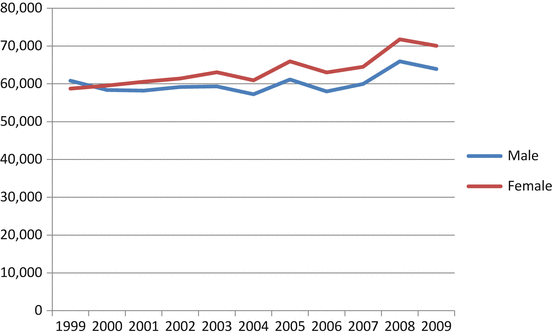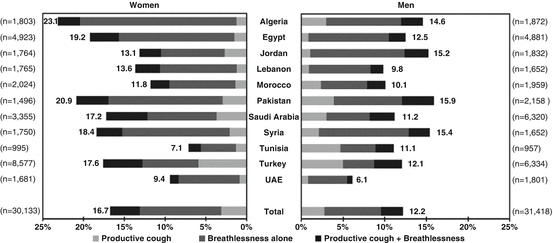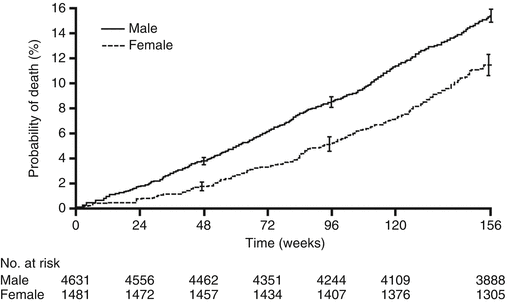Fig. 3.1
United States Smoking Rates (1974–2009) [9] Notes: (1) A current smoker is a person who has smoked at least 100 cigarettes and who now smokes. In 1992, the definition of a current smoker was modified to include persons who smoked every day or some days. (2) Because these estimates are based on a sample, they may differ from figures that would be obtained from a census of the population. Each data point reported is an estimate of the true population value and subject to sampling variability
Among young adults, however , the gender gap may be narrowing. Data from the National Survey on Drug Use and Health (NSDUH ) presented in Fig. 3.2 demonstrate that despite a decline in cigarette use among youths, the decline has been more rapid for males resulting in very little gender difference in cigarette use in this age group as of 2008 [11]. Additionally alarming is the increased use of electronic cigarettes particularly among youth. Many of these products are marketed specifically for women, but the long-term health effects are unknown as well as the likelihood of conversion to other tobacco products.
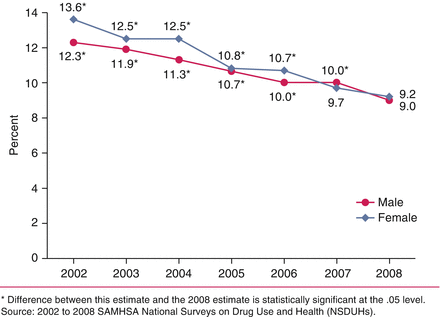

Fig. 3.2
Past month cigarette use among youths (Aged 12–17 by Gender: 2002–2008)
Also not to be overlooked as a risk factor for COPD is “secondhand” or environmental tobacco smoke exposure [12]. The particle exposure from secondhand smoke mimics that of direct smoking; thus the inflammation and lung tissue damage is expected to be similar to that of direct smoking. Women are more frequently exposed to environmental tobacco smoke [13], particularly in the home [14]. Greater exposure for women may be due to the lag in smoking trends between men and women resulting in more nonsmoking women living with smoking men [13]. Of particular concern, women with low incomes may experience even greater exposure to environmental tobacco smoke [15]. Women with lower incomes may have less ability to limit or control exposure; one study, for instance, demonstrated that smoke-free laws had a greater impact on reducing smoke exposure in “medium-education” females as compared to “low-education” females [16].
For women in developing countries , biomass fuel which is used as a source of energy and cooking is a significant risk factor for COPD particularly in women. Multiple studies have now documented a relationship between biomass exposure and the development of respiratory disease in women [17]. A recent meta-analysis showed that this particular environmental exposure increased the risk of COPD in women 2.4 times more than other fuel types [17]. Other attributable environmental exposures that likely contribute to COPD development include exposures to fumes and biologic and mineral dusts. Biologic dusts include such things as animal dander, bacteria, pollen, and fungi. A recent study demonstrated that exposure to biologic dusts in particular increased risk of COPD in women but not in men [18].
Disease Prevalence
As tobacco is the primary risk factor for COPD in the developed world, generally the prevalence of COPD mirrors tobacco use with greater prevalence of COPD among men. However, it should also be pointed out that due largely to widespread underdiagnosis and underutilization of spirometry, prevalence estimates for COPD have been difficult to ascertain with certainty and vary widely due to differences in methodologies used to capture the data. The National Health Interview Study (NHIS) which is based upon self-report of chronic bronchitis or emphysema suggests the overall prevalence of COPD in the United States to be relatively stable from 1998 through 2009 with prevalence among women higher than men (Table 3.1 ) in all but the oldest age group [6]. Similarly, age-adjusted prevalence of COPD was also higher in women (7.3 %) than in men (5.7 %) in the Behavioral Risk Factor Surveillance Study (BRFSS ) [19] whose methodology was also based upon self-report per telephone contact.
Table 3.1
Prevalence of COPD among adults aged 18 and over: United States 1998–2009
3-year period | Men | Women |
|---|---|---|
1998–2000 | 4.4 (0.1) | 6.7 (0.1) |
2001–2003 | 4.6 (0.1) | 6.7 (0.1) |
2004–2006 | 4.3 (0.1) | 6.3 (0.1) |
2007–2009 | 4.1 (0.1) | 6.1 (0.2) |
However, data from the National Health and Nutrition Examination Survey (NHANES ) reported a lower overall prevalence in the United States of COPD in women (10.8 %) as opposed to men (17.4 %) [20]. This survey used a multistage, probability sampling design where selected individuals actually underwent confirmatory spirometry. It is likely this methodology is more robust than self-report. NHANES data corroborate other global data where a generally higher prevalence among men has also been demonstrated trending similarly with differences in smoking rates [21].
Mortality
COPD is the third leading cause of death in the United States behind cancer and heart disease. Worldwide it is the fourth leading cause of morbidity and mortality, accounting for 5.8 % of all deaths [22]. It has been estimated that the annual deaths from COPD exceed lung cancer and breast cancer combined, accounting for 250 deaths per hour globally [22]. Trends in COPD death rates demonstrate a significant increase for both men and women who are current or former smokers, but the increase is most pronounced among current smokers [23] (Fig. 3.3). Unfortunately it is also projected that deaths from COPD will continue to increase by 30 % over the next 10 years [22].
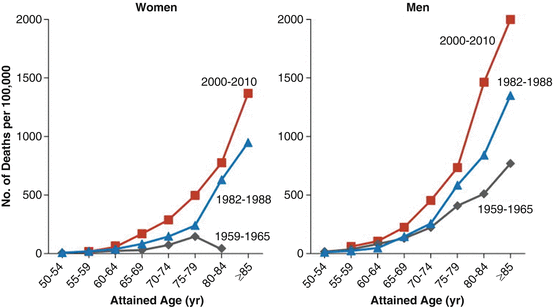

Fig. 3.3
Changes in rates of death from chronic obstructive pulmonary disease (COPD) over time among current female and male smokers in the three time periods [23]
With respect to gender differences in the United States, total deaths for women due to COPD have exceeded the number in men since 1999 (Table 3.2 and Fig. 3.4) [24]. However, the age-adjusted death rate for COPD is actually 1.3 times greater for men than women [25]. Figure 3.5 demonstrates the age-adjusted death rates for COPD by gender in the United States. The greater death rate due to COPD in men may reflect higher prevalence rates of COPD among men. The greater total number of COPD deaths for women may reflect more total women at the upper end of the age spectrum at risk for COPD death; women in general live longer [26] and may not be dying earlier of other causes as their male counterparts but rather living long enough to die of COPD.
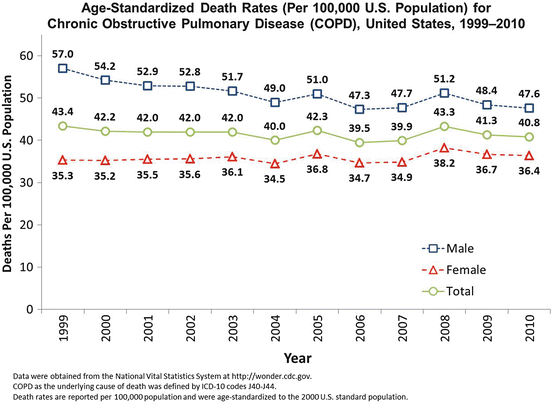
Table 3.2
Number of COPD deaths by Gender in the United States, 1999–2009
Year | Men | Women |
|---|---|---|
1999 | 60,795 | 58,729 |
2000 | 58,372 | 59,510 |
2001 | 58,218 | 60,526 |
2002 | 59,133 | 61,422 |
2003 | 59,321 | 63,062 |
2004 | 57,260 | 60,911 |
2005 | 61,120 | 65,929 |
2006 | 57,964 | 63,006 |
2007 | 59,961 | 64,516 |
2008 | 65,936 | 71,757 |
2009 | 63,899 | 70,066 |

Fig. 3.5
Age-standardized death rates (Per 100,000 U.S. Population) for chronic obstructive pulmonary disease (COPD), United States, 1999–2010 [107]
Bias in Diagnosis
An important feature of this chronic disease is the high rate of underdiagnosis for both genders. It is estimated that in the United States alone over 14 million people remain undiagnosed [3]. Furthermore, spirometry remains highly underutilized with only about a third of individuals who have been given a diagnosis of COPD having undergone confirmatory spirometry which also opens the door for misdiagnosis [27]. Any person who has dyspnea, sputum production, chronic cough, family history of COPD, or a history of exposure to risk factors (tobacco smoke, occupational chemicals/dust, smoke from fuels, and home cooking) should be evaluated for COPD [28]. From a clinical standpoint, spirometry is required to make a diagnosis of airflow obstruction [29]. It is estimated that of those undiagnosed, the majority are those with mild to moderate disease where arguably interventions such as smoking cessation would have the most long-term impact [30, 31].
With respect to gender bias in diagnosis, several studies have attempted to address this question. The first was a survey of primary care physicians in North America where a prototypical history of cough and dyspnea in a smoker were presented [32]. Primary care physicians were surveyed for a likely diagnosis given history and physical examination results where half the surveys described the patient as female and the other half as male. The likelihood of a correct COPD diagnosis was significantly greater for men than women (64.6 % vs. 49.9 %; p = 0.05) with greater likelihood of misdiagnosis of asthma in women. Once survey respondents were provided with spirometry, the gender gap in misdiagnosis narrowed was still present. A similar follow-up survey study was conducted in Europe which also demonstrated increased misdiagnosis in women which disappeared when physicians were presented with spirometric data suggesting some improvement in physician gender bias [31]. A recent population-based survey in Spain also reported women (86.0 %) were 1.27 times more likely to be underdiagnosed than men (65.6 %) [33].
Survey data from the United States also suggest that women are also more likely to perceive a delay in diagnosis attributing lack of availability of providers and insurance issues [34]. If women are being underdiagnosed, there are several potential reasons. As smoking and COPD are generally more prevalent in men, as the studies presented suggest, physicians may be more likely to suspect a diagnosis of COPD in men. Gender differences in clinical presentation may also contribute to bias in the diagnosis [35–38]. While smoking is the most significant risk factor for COPD in the developed world, women make up the majority of individuals with COPD who are nonsmokers and as such may not match the risk profile that care providers typically look for [39]. Socioeconomic differences and access to health care could also play a role. These data underscore the need for increased patient and physician awareness as well as the importance of appropriate diagnostic testing in symptomatic patients .
Tobacco Susceptibility
While more men than women may smoke, data suggest that women may be more susceptible to the harmful effects of tobacco smoke [40–42]. The Lung Health Study demonstrated a more rapid decline in women who continued to smoke as compared to men [43]. A systematic review and meta-analysis concluded that women experience a greater rate of decline in lung function than men for a similar amount of tobacco exposure [44] (Fig. 3.6). Data from the National Emphysema Treatment Trial also demonstrated that women with similar severe lung function to their male counterparts had fewer pack-years of smoking history [38].
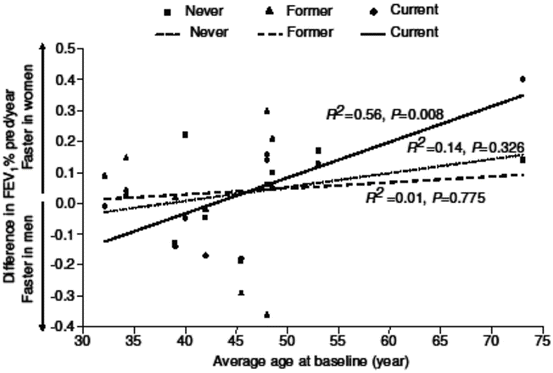

Fig. 3.6
Unweighted analysis of the relationship between age- and gender-related differences in the annual decline in FEV1 percentage predicted according to smoking status [44]
Several hypotheses have been offered as possible explanations for the increased susceptibility of women as compared to men to effects of tobacco smoke exposure. The lungs of women are relatively smaller than those of men, and thus each cigarette smoked may represent a higher relative “dose” for women. Some researchers have suggested that women may underreport tobacco use. However, this question has been examined. A meta-analysis of studies on tobacco reporting concluded that self-reported smoking data among women are generally accurate [45]. Secondhand smoke exposure and differences in cigarette brand preferences could also contribute to differences in susceptibility. Biological or hormonal differences between men and women have also been hypothesized to influence tobacco susceptibility [36, 37, 46, 47]. For instance, women have increased oxidative metabolism of several components of tobacco smoke. As a result, women may effectively experience a relatively higher and more prolonged exposure to oxidative substances that could accelerate the development of tobacco-related diseases, including lung cancer [48].
Disease Presentation
It is well established that the presence of cough, sputum production, and shortness of breath are classic symptoms of COPD, although increasing evidence suggests a difference in clinical symptom presentation by gender [49–51]. Most studies have found women to report more dyspnea than men despite similar lung function testing and fewer pack-years of smoking [35, 52, 53], although the data across studies are not completely consistent. The Confronting COPD International Survey demonstrated women were more likely to report severe dyspnea (OR, 1.30; 95 % CI, 1.10–1.54) despite significantly fewer pack-years of smoking, while reporting similar degrees of cough (OR, 84; 95 % CI, 0.72–0.98) [53]. In another prospective study of symptoms in male and female patients with mild to moderate COPD, similar proportions of men and women reported symptoms despite significantly greater pack-years of smoking in men [54]. Data from the international BREATHE study (Algeria, Egypt, Jordan, Lebanon, Morocco, Saudi Arabia, Syria, Tunisia, Turkey, and United Arab Emirates) (Fig. 3.7) also reported that respiratory symptoms (productive cough and/or breathlessness) were more frequently observed in women than men [55]. On the contrary another study from the United States found no difference in severe shortness of breath experienced between genders and decreased reports of cough by women [34]. Differences in sputum production are also not consistent. Some studies have reported men having a higher rate of productive cough than women, while other cite no differences in sputum production reporting [53, 56, 57]. Some have suspected that differences in sputum production reporting may be related to willingness of women to report such symptoms .
Health-related quality of life (HRQOL ) encompasses several dimensions including functional and symptom status, perception of health, biological/physical factors, and overall well-being [58]. It has been demonstrated that how one perceives HRQOL can impact health care outcomes [59]. Women tend to experience lower HRQOL than men as a result of COPD [52], even with similar lung function [35]. Gender differences have also been observed in the factors associated with decreased health-related quality of life. Chronic cough and sputum production, dyspnea, and oxygenation have been reported as significant predictors of a decreased health-related quality of life in women [8, 35], whereas exercise capacity, dyspnea, severity of lung hyperinflation, and comorbidities were reported as significant predictors of decreased health-related quality of life in men [35].
Other factors that may also contribute to this difference between genders include greater prevalence of anxiety and depression and increased frequency of COPD exacerbations among women [49, 52, 60–62]. Anxiety and depression are particularly pronounced in patients with COPD requiring hospitalization. Two studies of hospitalized patients with COPD recorded significantly higher anxiety scores in women than men [63, 64]. This is a particularly important issue as the risk of rehospitalization for patients with COPD has been demonstrated to be increased for patients with anxiety and low health status [65].
The experience of dyspnea encompasses physical, affective, and cognitive dimensions and the impact of dyspnea is a result not only by the degree of lung dysfunction but also the individual’s emotional response and interpretation of that sensation [46]. Neurobiologic studies demonstrate women have greater intrinsic sensitivity to noxious somatic sensations such as dyspnea [40]. Gender differences in the laterality of prefrontal cortical processing of noxious stimuli have been demonstrated with neuroimaging studies [66]. The prefrontal cortex is involved in the cognitive modulation of emotion and therefore may play a role in gender differences in the interpretation of dyspnea .
Health Care Utilization and Management
The presence of a chronic disease is associated with expected increases in health care utilization. Several large trials have provided data regarding COPD exacerbations in men and women. The Understanding of the Potential Long-Term Impact of Tiotropium (UPLIFT ) study followed nearly 6000 COPD patients over a 4-year time period treated with tiotropium versus placebo [67]. Overall exacerbation rates including moderate and severe events were higher for women as compared to men (p < 0.001; 95 % CI; 16–34 %) [67] (Fig. 3.8). The Toward a Revolution in COPD Health study (TORCH ) evaluated the risk of death in over 6000 COPD patients over a 3-year time period treated with salmeterol and fluticasone, salmeterol alone, or fluticasone alone. Again, higher rates of exacerbations were noted in women, but similar rates of exacerbation-related hospitalizations were noted between genders [67]. COPDGene , a large observational study of approximately 10,000 patients, also reported increased rates of exacerbations in women as compared to men [68]. Additionally, there is a shorter time to one’s first COPD exacerbation in women than men [49]. At this point, however, it is unknown whether these differences reflect a difference in disease biology, likelihood of reporting symptoms, or another factor such as differential presence of comorbidities. It has been hypothesized that diastolic dysfunction may play a role in COPD exacerbations [69], and it is well documented that diastolic heart failure, for instance, is more prevalent in women [70].
Interestingly, women’s perception of health care management differs from that of men. Martinez et al. found that as compared to men, women were more likely to report that the amount of time spent with physician was insufficient and that it was difficult getting access to them when they need them [34]. The time in obtaining a diagnosis was perceived to be longer for women and they felt less educational information was provided to them by their physicians than men [34]. They were also more likely than men to seek out health information from other patients and online sources [34]. Despite this difference, however, both men and women were equally satisfied with their overall disease management .
Differences in Disease Biology and Phenotype
In theory, gender differences in COPD between men and women may result from biologic, social, or psychosocial factors, but teasing out the specific factor(s) for any particular aspect of the disease remains challenging. Sex hormone differences have been implicated as having a contributory role, and developmental data would suggest that sex hormones affect airway function [40]. Boys, for instance, have higher incidence of asthma than girls until age 15 [40]. Following that, the reverse occurs where the incidence rate is higher in girls than in boys until the perimenopause [40]. The change in asthma incidence in girls coincident with puberty and menopause suggests a potential role for sex hormones in airway function in asthma, but as of yet, teasing out a similar relationship in COPD has proven elusive. A cohort study evaluating the association between postmenopausal hormone use and new diagnoses of asthma or COPD reported an increased risk of asthma compared with non-hormone use but no difference in incidence of newly diagnosed COPD [71]. Thus, while sex hormones appear to play a role in asthma, their contribution to COPD pathogenesis and gender differences in COPD remain unclear .
Disease physiology may also differ between men and women with COPD. For instance, the National Emphysema Trial (NETT ) reported that in a population of patients with severe emphysema, men were more likely than women to demonstrate bronchoreversibility [72]. However, the Lung Health Study found no difference in the frequency of bronchodilator response between men and women in a much milder patient population [73]. Therefore, the relationship between gender and bronchoreversibility in COPD may also be complicated by the amount of emphysema or overall disease severity.
Differences in radiographic type and distribution of lung abnormality between men and women with COPD have also been reported. The NETT reported that women had less severe overall emphysema, particularly in the periphery of the lung [74]. Histologic examination of resected tissue also suggested that the bronchioles in female patients had significantly thicker airway walls and smaller lumens. Interestingly, gender dimorphism in COPD was first suggested by Burrows et al. in 1987 when they hypothesized that there were two primary types of COPD: chronic asthmatic bronchitis and emphysema [75]. Burrows reported that in their cohort, those with chronic asthmatic bronchitis were more frequently female, whereas the emphysematous group were primarily male. More recent data from the COPDGene study also suggest that as compared to women, men in general had greater radiographically detected emphysema. However, in subjects with severe disease that would be more similar to the NETT patient population, no obvious differences in the amount of emphysema between men and women were seen although the distribution (peel versus core) in this study has not yet been examined. However, data from COPDGene did suggest that the wall area percent (wall thickness/total thickness) for subsegmental and subsubsegmental airways of women is greater than for men [37]. These phenotypic differences, if real, could potentially have important therapeutic implications.
Gender differences in genetic mechanisms in the pathogenesis of COPD may also exist. A study of early-onset COPD families found 71.4 % of those affected were women [76]. Furthermore, analysis of first-degree relatives of probands who were current or former smokers showed that female first-degree relatives had significantly greater lung function than their male first-degree relatives. These differences were only seen among current or ex-smokers, implying a genetic predisposition for smoking-related lung damage that is gender specific. Another study by the same group but in a different cohort again found that subjects with severe, early-onset COPD were predominantly female. A history of maternal respiratory disease was also present in many suggesting that mitochondrial DNA and X chromosome genes [77] could be playing a role and need to be further investigated.
Several studies over the past 10 years have also explored epigenetic mechanisms that contribute to COPD pathophysiology [78, 79] which certainly could play a role in gender differences in COPD. Hormone-induced DNA methylation and histone modification have been suggested by several lines of evidence, although this has not specifically yet been examined as a cause for gender differences in COPD [80]. Differences in gene expression, however, have been reported between men and women with COPD. Recently, sputum and blood were analyzed from participants in the ECLIPSE study, an observational cohort study in COPD [81]. The authors specifically examined genetic regulation pathways and determined that many genes important for mitochondrial functional, energy metabolism, and cellular response to pathogens show sex-specific regulatory connections [81]. These data suggest that many cellular functions may be under sex-specific regulatory control which could have very important implications ranging from disease pathogenesis to therapeutics .
Comorbidities in COPD
The importance of comorbidities in COPD is becoming increasingly recognized. Certain comorbid conditions such as cardiovascular disease and osteoporosis are more common in the COPD patient population. Other comorbidities such as overlap syndrome, the coexistence of COPD, and obstructive sleep apnea may not be more prevalent in COPD but are important as they may modify disease course [82]. Diabetes, hypertension, cardiovascular disease, and cancer have all been reported to increase the risk of death in COPD as well as significantly increase health care costs [83, 84, 85]. Certain comorbidities do appear to be more common in men versus women with COPD and therefore are worthy of discussion here. As was discussed earlier, anxiety and depression have been reported more frequently in women with COPD which may influence disease presentation and disease impact. In the general population, ischemic cardiac disease and systolic heart failure are in general more common in men while diastolic heart failure is more common in women [86]. In COPD specifically, a study of comorbidity in patients hospitalized for COPD also reported women to have a lower prevalence of ischemic heart disease but interestingly greater prevalence of heart failure, suggesting that diastolic dysfunction which is a more frequent cause of non-ischemic heart failure could be playing a greater role in women hospitalized with COPD [60]. Both ischemic heart disease and diastolic dysfunction could conceivably alter symptoms and quality of life or complicate or mimic exacerbations and thereby alter the presentation and clinical course for men versus women with COPD .
Osteoporosis i s seen more frequently in women than men in the general population and even COPD is reported more frequently by women [87]. Intriguingly, data from the COPDGene study using CT scans to analyze bone mineral density recently demonstrated that male smokers had a small but significantly greater risk of low bone density and vertebral fractures as compared to female smokers [88]. Presence of COPD itself was also associated with lower bone mineral density. This study also showed an association between CT detected airway disease and higher bone density. It has also been previously demonstrated that there is an association between emphysema and lower bone density. Thus, it is possible that women with COPD may be more prone to an “airway disease, high bone density” disease phenotype and men to an “emphysema, low bone density” phenotype .
Therapeutic Implications
Tobacco Cessation
There is continued controversy as to whether there are gender differences in the ability to stop smoking. The US Surgeon General’s report on women and smoking from 2001 concluded that women have more difficulty giving up smoking than men, both at short-term and long-term follow-up [89]. In studies using behavioral therapy, nicotine replacement, and bupropion, higher rates of tobacco cessation have been observed in men [43, 90–92]. However, the truth may be more complicated. In a study done in the United States, Canada, and United Kingdom using data from three majors surveys, it was found that younger women below the age of 50 were more likely to quit smoking than men, but after age 50 men were more likely to quit than women (Fig. 3.9).
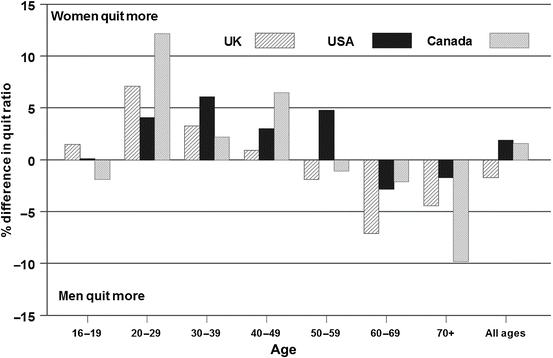 < div class='tao-gold-member'>
< div class='tao-gold-member'>





Only gold members can continue reading. Log In or Register to continue
Stay updated, free articles. Join our Telegram channel

Full access? Get Clinical Tree


